Chemical Constituents and Antiproliferative Activity Against RAFLs and HepG2 Cells of Clematis henryi
Abstract
1. Introduction
2. Results
2.1. Structure Elucidation
2.2. Anti-Proliferation Activity
2.2.1. Anti-Proliferative Activity on HFLs Cell
2.2.2. Anti-Proliferative Activity on RAFLs Cell
2.2.3. Anti-Proliferative Activity on HepG2 Cell
3. Discussion
4. Materials and Methods
4.1. General Experimental Procedures
4.2. Chemicals and Reagents
4.3. Plant Material
4.4. Extraction and Isolation
4.5. Anti-Proliferation Activity Assay
4.5.1. Anti-HFLs Cell Proliferation Activity
4.5.2. Anti-RAFLs Cell Proliferation Activity
4.6. Anti-HepG2 Cell Proliferation Activity
5. Conclusions
Supplementary Materials
Author Contributions
Funding
Institutional Review Board Statement
Informed Consent Statement
Data Availability Statement
Conflicts of Interest
References
- Zhang, Y.M.; Mu, Z.J.; Zhang, P.Z.; Zhong, G.Y. Ethnopharmacological Investigation of Chinese Clematis Plants. Chin. J. Exp. Tradit. Med. Formulae 2018, 24, 226–234. [Google Scholar] [CrossRef]
- Chen, X.; Chang, Q.; Xia, P.; Liang, Z.; Yan, K. The complete chloroplast genome of Clematis henryi var. ternata (Ranunculaceae). Mitochondrial DNA B Resour 2021, 6, 1319–1320. [Google Scholar] [CrossRef]
- Huang, Y.L.; Lu, J.X.; Jiang, M.; Li, W.P.; Zhang, X.Y.; Zou, Q.C. Callus induction and plant regeneration of Clematis henryi. Acta Agric. Zhejiangensis 2011, 23, 731–735. [Google Scholar]
- Yang, Q.; Xiao, W.T.; Liu, D.H. Simultaneous determination of nine effective components in Solidaginis Herba by QAMS. Chin. J. Pharm. Anal. 2024, 44, 1186–1194. [Google Scholar]
- Liu, S.; Xiang, D.X.; Yan, M.; Du, F.L. Study on the Chemical Constituents of Clematis Henryi. Chin. Tradit. Pat. Med. 2007, 9, 1379–1380. [Google Scholar]
- Sun, X.B.; Zhang, K.; Li, L.L.; Xiang, D.X. Separation and purification of total saponins from Clematis henryi by macroporous resins Chin. Tradit. Herb. Drugs 2011, 42, 1977–1981. [Google Scholar]
- Zhao, B.Q.; Li, Q.; Chen, W.P. Ten Commonly Used Medicinal Herbs of Ethnic Minorities in Hunan. Chin. J. Ethnomed. Ethnopharm. 2001, 2, 101–103. [Google Scholar]
- Song, Z.H.; Zhao, Y.Y.; Duan, L.J.; Wang, X. Review of chemical constituents and pharmacological actions of clematis species. Nat. Prod. Res. Dev. 1995, 2, 66–72. [Google Scholar] [CrossRef]
- Hsieh, M.S.; Wang, K.T.; Tseng, S.H.; Lee, C.J.; Chen, C.H.; Wang, C.C. Using 18F-FDG microPET imaging to measure the inhibitory effects of Clematis chinensis Osbeck on the pro-inflammatory and degradative mediators associated with inflammatory arthritis. J. Ethnopharmacol. 2011, 136, 511–517. [Google Scholar] [CrossRef] [PubMed]
- Wan, Y.; Yuan, S.; Xue, X.; Li, M.; Qin, X.; Zhang, C.; Wang, W.; Jiang, C.; Wu, S.; Liu, Y.; et al. The preventive effect of adjuvant-free administration of TNF-PADRE autovaccine on collagen-II-induced rheumatoid arthritis in mice. Cell. Immunol. 2009, 258, 72–77. [Google Scholar] [CrossRef] [PubMed]
- Svelander, L.; Erlandsson-Harris, H.; Astner, L.; Grabowska, U.; Klareskog, L.; Lindstrom, E.; Hewitt, E. Inhibition of cathepsin K reduces bone erosion, cartilage degradation and inflammation evoked by collagen-induced arthritis in mice. Eur. J. Pharmacol. 2009, 613, 155–162. [Google Scholar] [CrossRef]
- Sun, S.X.; Li, Y.M.; Fang, W.R.; Cheng, P.; Liu, L.; Li, F. Effect and mechanism of AR-6 in experimental rheumatoid arthritis. Clin. Exp. Med. 2010, 10, 113–121. [Google Scholar] [CrossRef]
- Peng, C.; Perera, P.K.; Li, Y.M.; Fang, W.R.; Liu, L.F.; Li, F.W. Anti-inflammatory effects of Clematis chinensis Osbeck extract(AR-6) may be associated with NF-κB, TNF-α, and COX-2 in collagen-induced arthritis in rat. Rheumatol. Int. 2012, 32, 3119–3125. [Google Scholar] [CrossRef] [PubMed]
- Obiri, D.D.; Osafo, N.; Ayande, P.G.; Antwi, A.O. Xylopia aethiopica (Annonaceae) fruit extract suppresses Freund’s adjuvant-induced arthritis in Sprague-Dawley rats. J. Ethnopharmacol. 2014, 152, 522–531. [Google Scholar] [CrossRef]
- Zhang, L.T.; Zhang, Y.W.; Takaishi, Y.; Duan, H.Q. Antitumor triterpene saponins from Anemone flaccida. Chin. Chem. Lett. 2008, 19, 190–192. [Google Scholar] [CrossRef]
- Pan, T.; Cheng, T.F.; Jia, Y.R.; Li, P.; Li, F. Anti-rheumatoid arthritis effects of traditional Chinese herb couple in adjuvant-induced arthritis in rats. J. Ethnopharmacol. 2017, 205, 1–7. [Google Scholar] [CrossRef]
- Liu, Q.; Xiao, X.H.; Hu, L.B.; Jie, H.Y.; Wang, Y.; Ye, W.C.; Li, M.M.; Liu, Z. Anhuienoside C Ameliorates Collagen-Induced Arthritis through Inhibition of MAPK and NF-κB Signaling Pathways. Front. Pharmacol. 2017, 8, 299. [Google Scholar] [CrossRef] [PubMed]
- Sun, X.B. Exploration of Extraction, Purification Technique and Anti-Rheumatoid Activity of Total Saponins from Radix Clematidis Henryi. Master’s Thesis, Central South University, Changsha, China, 2011. [Google Scholar]
- Hu, H.H.; Fu, Y.L.; Liao, H.L.; Long, Y.; Zhong, S.H. Exploration of Extraction Technique for Total Saponins from Radix Clematidis Henryi by Styrenic Polymers. Fine Chem. Intermed. 2019, 49, 44–47. [Google Scholar] [CrossRef]
- Yan, M. Chemical Constituents Study of Clematis Henryi. Master’s Thesis, Hunan University of Chinese Medicine, Changsha, China, 2006. [Google Scholar]
- Liu, C.L.; Duan, Y.H.; Dai, Y.; Yao, X. Study on the Chemical Constituents of Roots and Stems of Nardostachys Chinensis. J. Chin. Med. Mater. 2011, 34, 1216–1219. [Google Scholar] [CrossRef]
- Zu, X.P.; Zhang, W.D.; Han, Z.Z.; Li, H.L. Water soluble chemical constituents of Valeriana of ficinalis Linn. var. latio folia Miq. Acad. J. Nav. Med. Univ. 2014, 35, 161–170. [Google Scholar] [CrossRef]
- Cai, L.; Shao, S.Y.; Han, S.W.; Li, S. Sesquiterpenoids, phenolic and lignan glycosides from the roots and rhizomes of Clematis hexapetala Pall. and their bioactivities. Bioorg. Chem. 2020, 104, 104312. [Google Scholar] [CrossRef]
- Yang, B.Y.; Lu, Z.K.; Liu, Y.; Guo, H.W.; Kuang, H.X. Isolation and Identification of Chemical Constituents from Stems of Datura Metel. Chin. J. Exp. Tradit. Med. Formulae 2017, 23, 34–40. [Google Scholar] [CrossRef]
- Kil, H.W.; Rho, T.; Yoon, K.D. Phytochemical Study of Aerial Parts of Leea asiatica. Molecules 2019, 24, 1733. [Google Scholar] [CrossRef]
- Zendah el Euch, I.; Shaaban, K.; Riaz, N.; Shaaban, M.; Bahi, M. Bioactive metabolites from the ruminal bacterium Enterobacter amnigenus ZIH. Indian J. Nat. Prod. Resour. 2018, 9, 222–228. [Google Scholar]
- Niwa, M.; He, Y.-H.; Dou, D.-Q.; Terashima, K.; Takaya, Y. Two Lignan Glycosides from Vitis thunbergii. Heterocycles 2004, 63, 871–877. [Google Scholar] [CrossRef]
- Zeng, X.; Wang, H.; Gong, Z.; Huang, J.; Pei, W.; Wang, X.; Zhang, J.; Tang, X. Antimicrobial and cytotoxic phenolics and phenolic glycosides from Sargentodoxa cuneata. Fitoterapia 2015, 101, 153–161. [Google Scholar] [CrossRef]
- Balázs, B.; Tóth, G.; Duddeck, H.; Soliman, H.S. Iridoid and lignan glycosides from Citharexylum spinosum L. Nat. Prod. Res. 2006, 20, 201–205. [Google Scholar] [CrossRef]
- Wu, Q.; Bang, M.-H.; Cho, J.-G.; Lee, D.-Y.; Lee, K.-T.; Chung, H.-G.; Choi, M.-S.; Jeong, T.-S.; Ahn, E.-M.; Kim, G.-S.; et al. Phenolic Compounds from the Roots of Brassica rapa ssp. campestris. Chem. Nat. Compd. 2013, 49, 852–856. [Google Scholar] [CrossRef]
- Park, J.-H.; Yeon, S.-W.; Cho, J.-G.; Lee, D.-Y.; Kim, Y.-S.; Baek, N.-I. Lignans from silkworm droppings and their promotional activities on heme oxygenase-1 (HO-1). J. Korean Soc. Appl. Biol. Chem. 2010, 53, 734–739. [Google Scholar] [CrossRef]
- Kim, D.K.; Lim, J.P.; Kim, J.W.; Park, H.W.; Eun, J.S. Antitumor and antiinflammatory constituents from Celtis sinensis. Arch. Pharmacal Res. 2005, 28, 39–43. [Google Scholar] [CrossRef] [PubMed]
- Park, H.B.; Lee, K.H.; Kim, K.H.; Lee, I.K.; Noh, H.J.; Choi, S.U.; Lee, K.R. Lignans from the Roots of Berberis amurensis. Nat. Prod. Sci. 2009, 15, 17–21. [Google Scholar]
- In, S.J.; Seo, K.H.; Song, N.Y.; Lee, D.S.; Kim, Y.C.; Baek, N.I. Lignans and neolignans from the stems of Vibrunum erosum and their neuroprotective and anti-inflammatory activity. Arch. Pharmacal Res. 2015, 38, 26–34. [Google Scholar] [CrossRef]
- Chin, Y.W.; Chai, H.B.; Keller, W.J.; Kinghorn, A.D. Lignans and other constituents of the fruits of Euterpe oleracea (Acai) with antioxidant and cytoprotective activities. J. Agric. Food Chem. 2008, 56, 7759–7764. [Google Scholar] [CrossRef]
- Kuang, H.X.; Xia, Y.G.; Yang, B.Y.; Wang, Q.H.; Lü, S.W. Lignan constituents from Chloranthus japonicus Sieb. Arch. Pharmacal Res. 2009, 32, 329–334. [Google Scholar] [CrossRef]
- Xie, L.H.; Akao, T.; Hamasaki, K.; Deyama, T.; Hattori, M. Biotransformation of pinoresinol diglucoside to mammalian lignans by human intestinal microflora, and isolation of Enterococcus faecalis strain PDG-1 responsible for the transformation of (+)-pinoresinol to (+)-lariciresinol. Chem. Pharm. Bull. 2003, 51, 508–515. [Google Scholar] [CrossRef]
- Wu, Q.; Wang, S.C.; Sheng, W.B.; Yao, M.; Yuan, H.W.; Wang, W.; Li, B.; Peng, C.Y. Advances on natural sources norlignan compounds and their biological activities. Chin. Tradit. Herb. Drugs 2021, 52, 1522–1535. [Google Scholar]
- Gurgul, A.; Nauman, M.C.; Wu, Z.; Shetye, G.; Ma, R.; Youn, I.; Souliya, O.; Bisson, J.; Johnson, J.J.; Che, C.T. Chemical constituents of the stem of Marsypopetalum modestum and their bioactivities. Nat. Prod. Res. 2023, 37, 3623–3630. [Google Scholar] [CrossRef]
- Yang, D.S.; Yuan, J.Y.; Han, Y.; Zhang, Q.Q.; Wang, T.; Zhang, Y. Isolation and identification of phenolic constituents from the stems of Ohwia caudata (Thunberg) H. Ohashi. Chin. J. Med. Chem. 2022, 32, 862–869. [Google Scholar] [CrossRef]
- Huang, S.Z.; Jiang, S.P.; Zhu, H.J. A new phenylpropanoid glycoside from Tibetan folk drog pulicaria insignis. Nat. Prod. Res. Dev. 2009, 21, 549–552. [Google Scholar] [CrossRef]
- Kong, C.-S.; Um, Y.R.; Lee, J.I.; Kim, Y.A.; Yea, S.S.; Seo, Y. Constituents isolated from Glehnia littoralis suppress proliferations of human cancer cells and MMP expression in HT1080 cells. Food Chem. 2010, 120, 385–394. [Google Scholar] [CrossRef]
- Guo, Y.X.; Xi, S.Y.; Ma, Y.; Lin, L.; Zan, Z.L.; Jin, L. Advances in the Chemical Constituents and Pharmacological Activities of the Euonymus alatus. Chin. J. Mod. Appl. Pharm. 2021, 38, 2305–2316. [Google Scholar] [CrossRef]
- Tanaka, N.; Murakami, T.; Wada, H.; Gutierrez, A.B.; Saiki, Y.; Chen, C. Chemical and Chemotaxonomical Studies of Filices. LXI. Chemical Studies on the Constituents of Pronephrium triphyllum HOLLT. Chem. Pharm. Bull. 1985, 33, 5231–5238. [Google Scholar] [CrossRef]
- Tanaka, N.; Sada, T.; Murakami, T.; Saiki, Y.; Chen, C. Chemische und Chemotaxonomische Untersuchungen der Pterophyten. XLV. Chemische Untersuchungen der Inhaltsstoffe von Glaphyropteridopsis erubescens (WALL.) COPEL. Chem. Pharm. Bull. 1984, 32, 490–496. [Google Scholar] [CrossRef]
- Liu, C.; Lei, Y.; Li, G.; Yuan, C.; Lv, Y.; Yu, S.; Shao, Y.; Dang, J. Three new dihydroflavonols with free radical scavenging activity from Ribes himalense Royle ex Decne. Nat. Prod. Res. 2022, 36, 5490–5498. [Google Scholar] [CrossRef]
- Nunomura, R.D.C.; Guedes, V.; Da Silva, S.; Nunomura, S. Characterization of Bergenin in Endopleura uchi Bark and its Anti-Inflammatory Activity. J. Braz. Chem. Soc.-JBCS 2009, 20, 1060–1064. [Google Scholar] [CrossRef]
- Ono, M.; Ueno, M.; Masuoka, C.; Ikeda, T.; Nohara, T. Iridoid glucosides from the fruit of Genipa americana. Chem. Pharm. Bull. 2005, 53, 1342–1344. [Google Scholar] [CrossRef]
- Kitagawa, I.; Wei, H.; Nagao, S.; Mahmud, T.; Hori, K.; Kobayashi, M.; Uji, T.; Shibuya, H. Indonesian Medicinal Plants. XIV. Characterization of 3′-O-Caffeoylsweroside, a new secoiridoid glucoside, and kelampayosides A and B, two new phenolic apioglucosides, from the bark of Anthocephalus chinensis (Rubiaceae). Chem. Pharm. Bull. 1996, 44, 1162–1167. [Google Scholar] [CrossRef]
- Douros, A.; Hadjipavlou-Litina, D.; Nikolaou, K.; Skaltsa, H. The Occurrence of Flavonoids and Related Compounds in Cedrus brevifolia A. Henry ex Elwes & A. Henry Needles. Inhibitory Potencies on Lipoxygenase, Linoleic Acid Lipid Peroxidation and Antioxidant Activity. Plants 2018, 7, 1. [Google Scholar] [CrossRef]
- Toshio, M.; Akira, U.; Nobuo, T.; Hiromi, K.; Hirook, O. Studies on the Glycosides of Epimedium grandiflorum MORR. var. thunbergianum (MIQ.) NAKAI. II (Pharmacognosy, Chemical). Chem. Pharm. Bull. 1987, 35, 3713–3719. [Google Scholar]
- Yang, R.; Fang, L.; Li, J.; Zhang, Y.Q. A new anti-inflammatory lignan from Lonicerae Japonicae flos. Nat. Prod. Res. 2021, 35, 587–592. [Google Scholar] [CrossRef]
- Majdalawieh, A.F.; Ahari, S.H.; Yousef, S.M.; Nasrallah, G.K. Sesamol: A lignan in sesame seeds with potent anti-inflammatory and immunomodulatory properties. Eur. J. Pharmacol. 2023, 960, 176163. [Google Scholar] [CrossRef] [PubMed]
- Chen, J.Y.; Shi, C.Y.; Shi, X.Y.; Liu, J.Q. Research progress on chemical structures and pharmacological effects of terpenoid lignans from natural sources. Nat. Prod. Res. Dev. 2024, 36, 1625–1637. [Google Scholar] [CrossRef]
- Ding, L.F.; Liu, J.; Song, J.F.; Lei, T.; Nie, W.; Song, L.D.; Wu, X.D. Lignans from leaves of Magnolia liliflora and their anti-inflammatory activities. Chin. Tradit. Herb. Drugs 2022, 53, 3912–3919. [Google Scholar]
- Lian, T.T.; He, Y.L.; Xin, L.; Meng, K.T.; Liu, Y.H.; Su, Z.W. Quassinoids and lignans from Brucea javanica and their antiinflammatory activities. Chin. Tradit. Pat. Med. 2024, 46, 4035–4041. [Google Scholar]
- Song, A.; Ding, T.; Wei, N.; Yang, J.; Ma, M.; Zheng, S.; Jin, H. Schisandrin B induces HepG2 cells pyroptosis by activating NK cells mediated anti-tumor immunity. Toxicol. Appl. Pharmacol. 2023, 472, 116574. [Google Scholar] [CrossRef]
- Ren, Y.H.; Qu, C.; Bai, T.Y.; Lv, X.L.; Liu, Y.X.; Fan, L. Evaluation of the Pharmacological Efficacy and Network Pharmacological Mechanisms of Total Lignans of Syringae Ramuls Against Liver Cancer. J. Med. Res. 2025, 54, 95–102+136. [Google Scholar]
- Wang, Y. Effects of Schisandra Polysaccharides and Lignans on Programmed Death of HepG2 Cells. Master’s Thesis, Jilin Agricultural University, Changchun, China, 2024. [Google Scholar]
- Huang, P.Q.; Kang, K.W.; Huang, D.Y.; Zhao, C.L.; Zheng, H.; Luo, Y.X.; Wen, Y.; Zou, M.F.; Li, D.L.; Wu, R.H.; et al. Lignan glucosides from Gentiana macrophylla with potential anti-arthritis and hepatoprotective activities. Phytochemistry 2024, 217, 113920. [Google Scholar] [CrossRef] [PubMed]
- Mao, J.N.; Huang, H.X.; Chen, G.Y.; Wu, J.J.; Xie, Q.L.; Liu, S.Q.; Zhan, S.; Peng, Z.; Zhou, X.D.; Wang, W. A novel aliphatic glycoside and a new lignan glycoside from Siraitia grosvenorii and their hepatoprotective activities. Nat. Prod. Res. 2025, 1–12. [Google Scholar] [CrossRef]
- Zeng, Q.C.; Wang, K.; Wan, J.C.; Song, Z.R.; Zhang, Z.H.; Wang, C.M.; Li, H.; Chen, J.G.; Sun, J.H. Pharmacokinetic Analysis of 8 Lignans in Acute Alcoholic Liver Injury Mice after Oral Administration of Total Schisandra chinensis Lignans. J. Beihua Univ. (Nat. Sci.) 2024, 25, 738–743. [Google Scholar]
- Liu, Y.Y.; Huang, S.Q.; Li, Y.Z.; Fan, H.; Zhang, H.W.; Deng, C.; Song, X.M.; Zhang, D.D.; Wang, W. Research progress on lignans and pharmacological activities in plants of Schisandra. Chin. Tradit. Herb. Drugs 2022, 53, 1903–1918. [Google Scholar]
- Liu, C.C.; Abd El-Razek, M.H.; Liaw, C.C.; Cheng, Y.B.; Chen, C.K.; Chien, C.T.; Kuo, Y.H.; Liou, S.S.; Shen, Y.C. Arisanschinins A-E, lignans from Schisandra arisanensis hay. Planta Med. 2010, 76, 1605–1610. [Google Scholar] [CrossRef] [PubMed]
- Wang, X.; Yu, J.; Li, W.; Wang, C.; Li, H.; Ju, W.; Chen, J.; Sun, J. Characteristics and Antioxidant Activity of Lignans in Schisandra chinensis and Schisandra sphenanthera from Different Locations. Chem. Biodivers. 2018, 15, e1800030. [Google Scholar] [CrossRef] [PubMed]
- Ma, Y.H.; Feng, B.; Zhu, H.Y.; Yu, H. Antioxidant and Anti-inflammatory Activity Study of Total Lignin from Schisandra chinensis (Turcz.) Baill. Food Res. Dev. 2019, 40, 25–30. [Google Scholar]
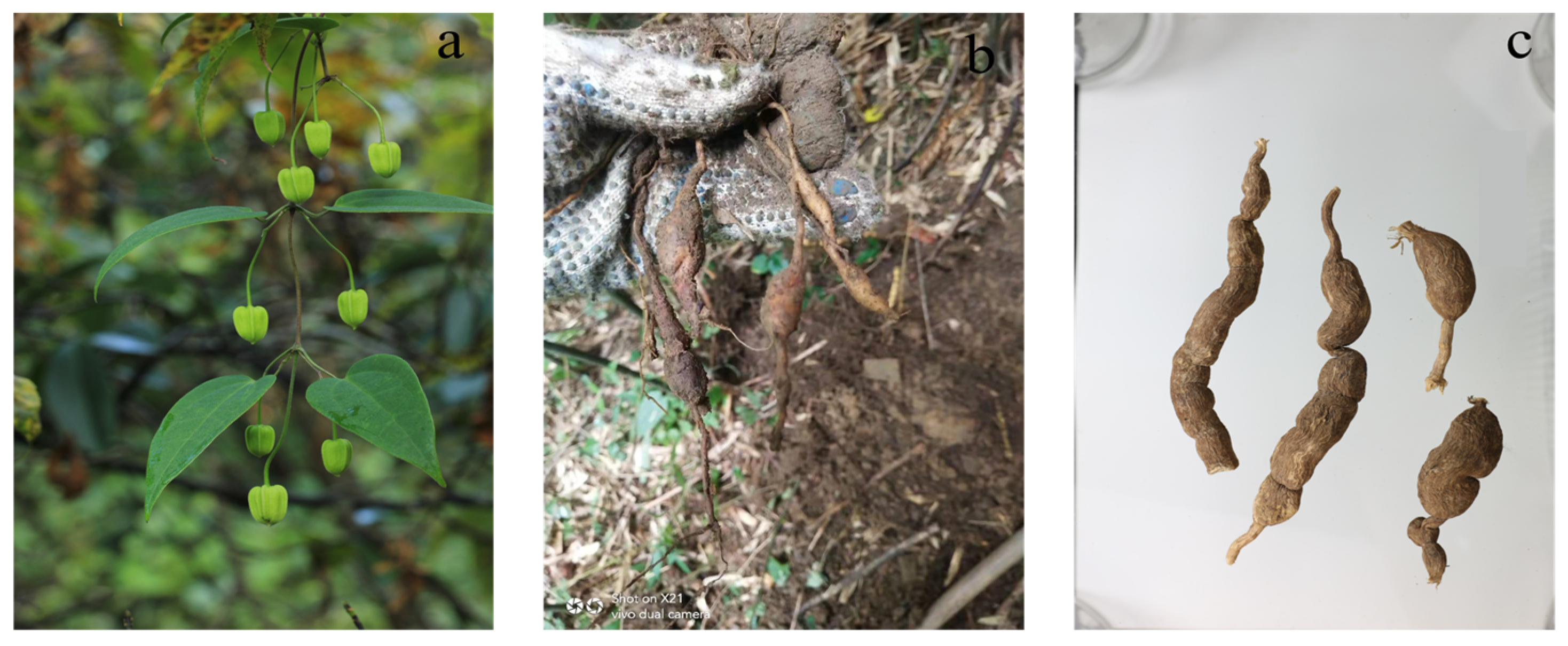

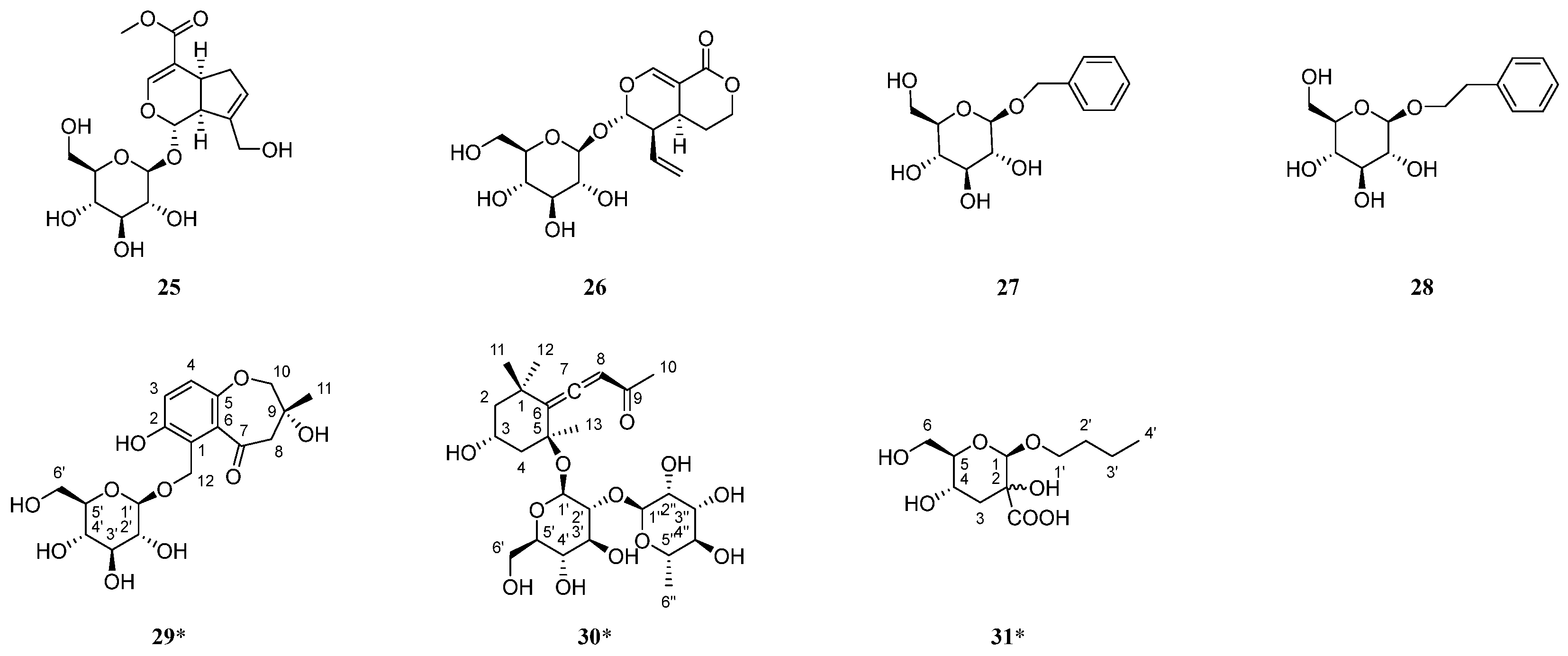
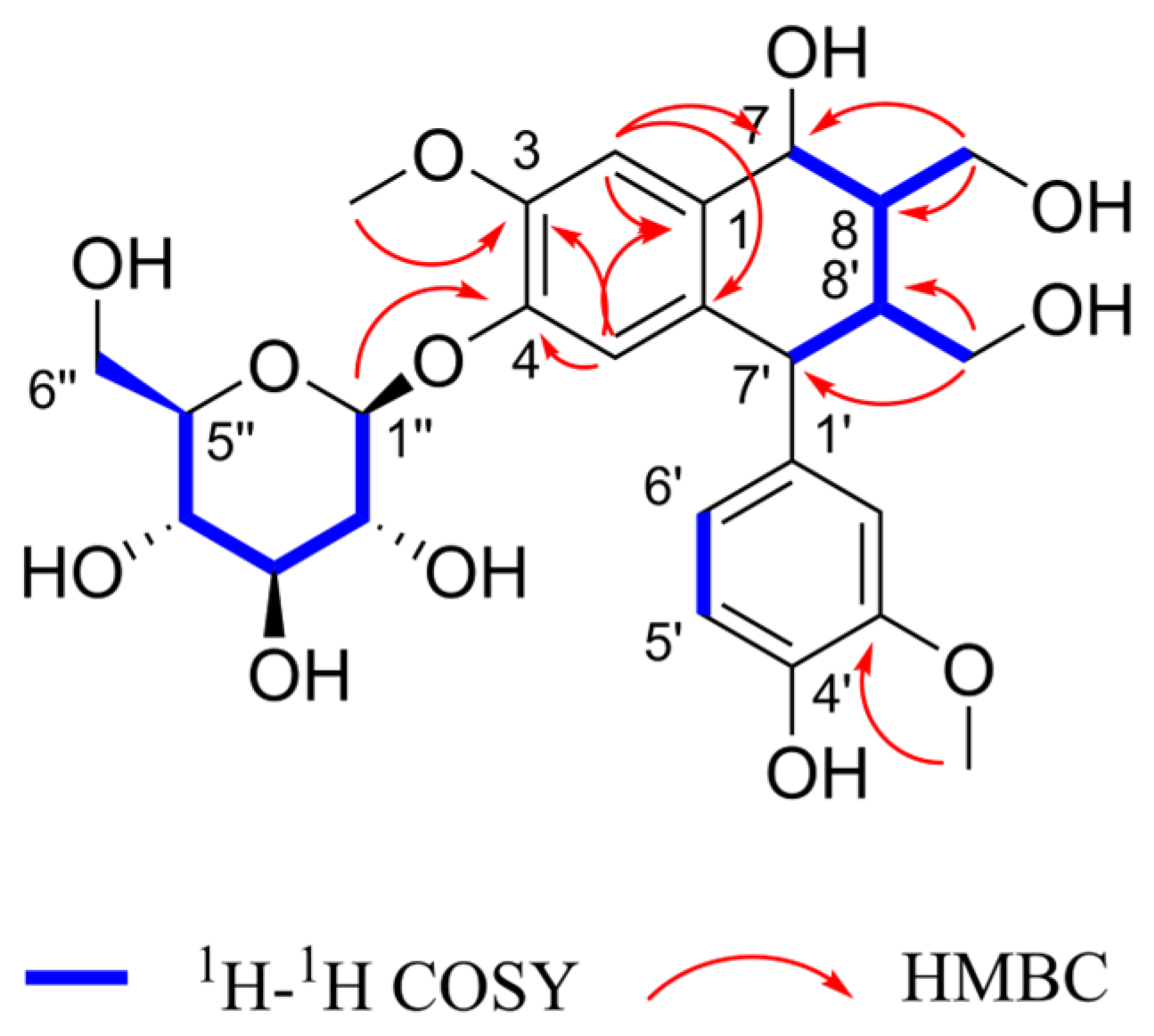

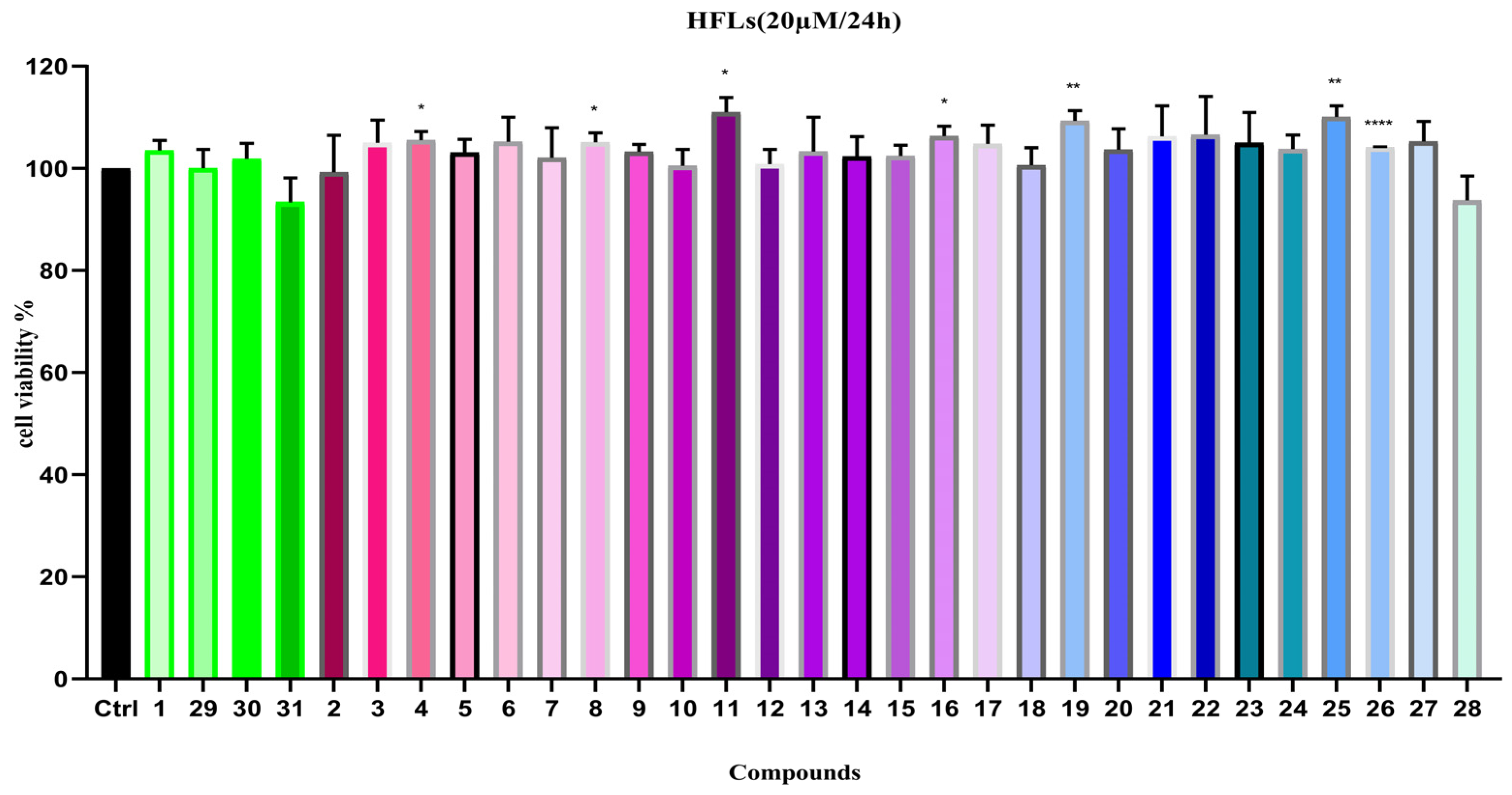

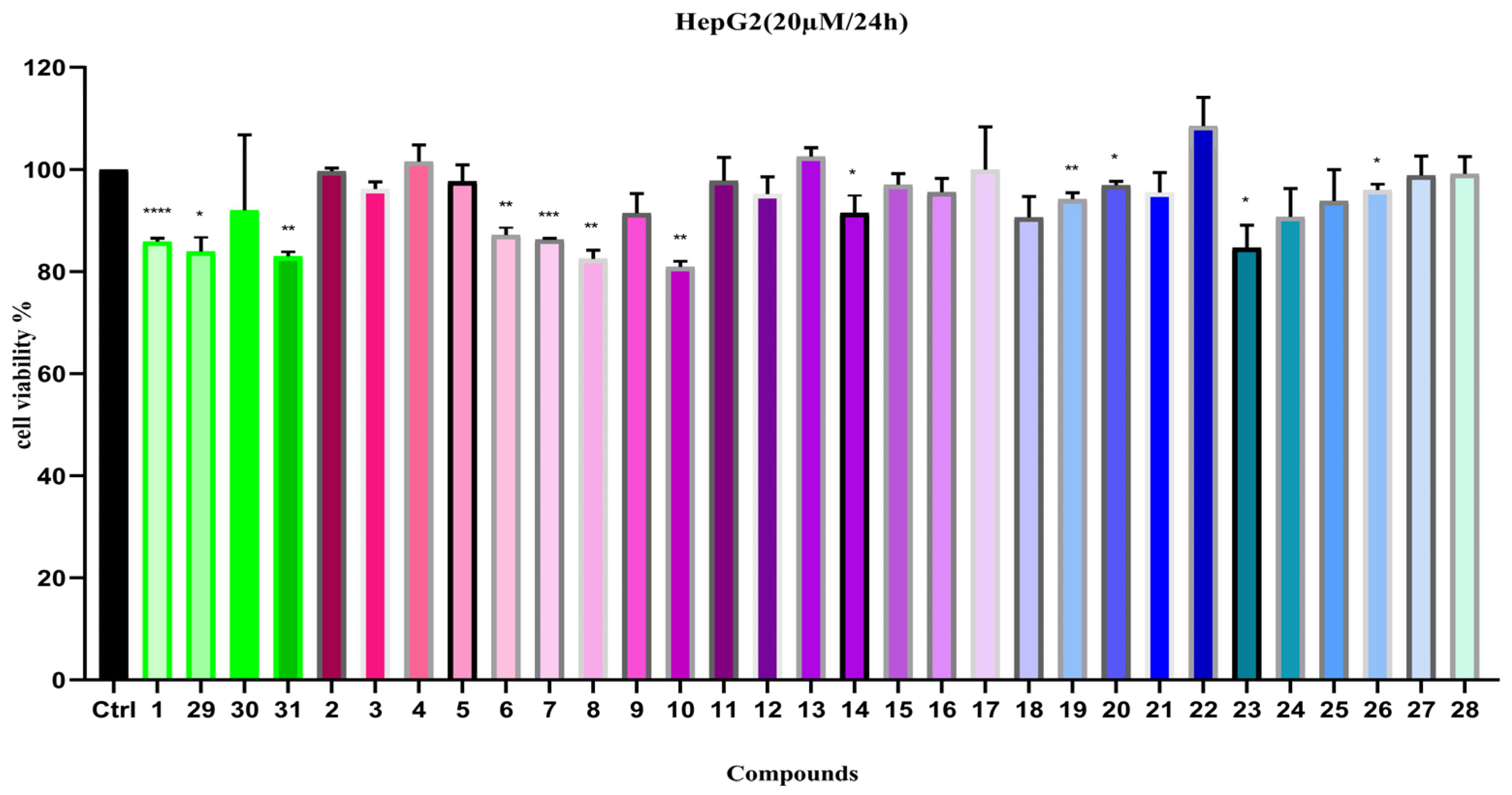

| No. | δC | δH |
|---|---|---|
| 1 | 129.3 | - |
| 2 | 120.8 | 6.99, s |
| 3 | 149.8 | - |
| 3-OCH3 | 56.8 | 3.91, s |
| 4 | 147.6 | - |
| 5 | 114.2 | 6.92, s |
| 6 | 134.3 | - |
| 7 | 79.8 | 4.85, m |
| 8 | 48.2 | 2.45, s |
| 9 | 61.4 | 3.42, m 3.20, dd (5.6, 3.7) |
| 1′ | 136.9 | - |
| 2′ | 113.9 | 6.78, d (2.1) |
| 3′ | 148.7 | - |
| 3′-OCH3 | 56.5 | 3.79, s |
| 4′ | 145.9 | - |
| 5′ | 115.7 | 6.71, d (8.2) |
| 6′ | 122.5 | 6.56, dd (8.2, 2.1) |
| 7′ | 50.8 | 4.14, s |
| 8′ | 45.9 | 2.87, s |
| 9′ | 76.2 | 4.16, dd (8.1, 5.2) 3.82, d (7.6) |
| 1″ | 103.0 | 4.78, d (7.7) |
| 2″ | 74.8 | 3.47, dd (9.0, 7.8) |
| 3″ | 77.8 | 3.39, d (8.7) |
| 4″ | 71.2 | 3.36, t (8.8) |
| 5″ | 78.2 | 3.20, dd (5.6, 3.7) |
| 6″ | 62.3 | 3.73, dd, (12.2, 2.2) 3.61, dd (12.1, 5.4) |
| No. | 29 | No. | 30 | ||
|---|---|---|---|---|---|
| δC | δH | δC | δH | ||
| 1 | 123.2 | - | 1 | 37.0 | - |
| 2 | 153.2 | - | 2 | 49.8 | 1.92, ddd (12.5, 4.3, 2.0) 1.34, d (11.9) |
| 3 | 120.3 | 6.86, d (8.8) | 3 | 63.8 | 4.23, tt (11.3, 4.1) |
| 4 | 122.5 | 6.92, d (8.8) | 4 | 50.4 | 2.46, ddd (13.2, 4.3, 2.0) 1.42, m |
| 5 | 154.7 | - | 5 | 78.1 | - |
| 6 | 132.9 | - | 6 | 118.6 | - |
| 7 | 203.4 | - | 7 | 201.0 | - |
| 8 | 58.0 | 3.11, d (11.4) 2.92, d (11.2) | 8 | 101.4 | 5.93, s |
| 9 | 74.1 | - | 9 | 213.0 | - |
| 10 | 82.6 | 4.00, d (12.4) 3.83, d (8.9) | 10 | 26.7 | 2.19, s |
| 11 | 25.1 | 1.28, s | 11 | 30.4 | 1.38, s |
| 12 | 63.0 | 5.10, d (11.1) 4.84, d (11.1) | 12 | 32.5 | 1.16, s |
| 1′ | 103.7 | 4.31, d (7.9) | 13 | 25.6 | 1.49, s |
| 2′ | 75.1 | 3.14, d (7.9) | 1′ | 97.9 | 4.61, d (7.6) |
| 3′ | 78.0 | 3.25, m | 2′ | 78.1 | 3.37, d (8.3) |
| 4′ | 71.5 | 3.29, d (8.6) | 3′ | 79.7 | 3.45, m |
| 5′ | 78.1 | 3.33, d (8.7) | 4′ | 72.2 | 3.20, t (9.2) |
| 6′ | 62.7 | 3.85, d (8.5) 3.69, dd (11.9, 5.4) | 5′ | 77.8 | 3.16, m |
| No. | 31 | 6′ | 63.0 | 3.81, dd (11.5, 2.3) 3.59, dd (11.5, 5.6) | |
| δC | δH | 1″ | 101.6 | 5.35, s | |
| 1 | 91.3 | 4.70, s | 2″ | 72.2 | 3.90, dd (3.5, 1.7) |
| 2 | 99.3 | - | 3″ | 72.3 | 3.69, dd (9.5, 3.4) |
| 3 | 39.1 | 2.54, dd (14.0, 4.7) 2.10, dd (13.9, 6.4) | 4″ | 74.1 | 3.40, m |
| 4 | 72.5 | 4.27, m | 5″ | 69.8 | 4.03, dq (9.6, 6.2) |
| 5 | 87.3 | 3.80, q (4.3) | 6″ | 18.1 | 1.30, d (6.2) |
| 6 | 63.6 | 3.61, m | |||
| 7 | 163.6 | - | |||
| 1′ | 68.6 | 3.58, m 3.49, m | |||
| 2′ | 32.9 | 1.58, m | |||
| 3′ | 20.4 | 1.42, m | |||
| 4′ | 14.2 | 0.94, t | |||
| Compound | IC50 | |
|---|---|---|
| 24 h | 48 h | |
| PTX * | 0.52 ± 0.10 | 0.46 ± 0.04 |
| 1 | 20.15 ± 0.04 | / |
| 8 | 27.91 ± 0.65 | 19.73 ± 0.35 |
| 10 | 30.47 ± 21.55 | 17.57 ± 0.10 |
| 29 | 16.07 ± 0.22 | 19.83 ± 0.59 |
| 30 | / | 19.8 ± 0.63 |
| 31 | 20.05 ± 0.50 | / |
Disclaimer/Publisher’s Note: The statements, opinions and data contained in all publications are solely those of the individual author(s) and contributor(s) and not of MDPI and/or the editor(s). MDPI and/or the editor(s) disclaim responsibility for any injury to people or property resulting from any ideas, methods, instructions or products referred to in the content. |
© 2025 by the authors. Licensee MDPI, Basel, Switzerland. This article is an open access article distributed under the terms and conditions of the Creative Commons Attribution (CC BY) license (https://creativecommons.org/licenses/by/4.0/).
Share and Cite
Wang, B.; Wang, M.-Y.; Yang, Y.-P.; Su, W.; Jiang, X.; Liu, S.-Q.; Luo, Q.-J.; Zhou, W.-C.; Liang, L.; Zheng, H.; et al. Chemical Constituents and Antiproliferative Activity Against RAFLs and HepG2 Cells of Clematis henryi. Int. J. Mol. Sci. 2025, 26, 11216. https://doi.org/10.3390/ijms262211216
Wang B, Wang M-Y, Yang Y-P, Su W, Jiang X, Liu S-Q, Luo Q-J, Zhou W-C, Liang L, Zheng H, et al. Chemical Constituents and Antiproliferative Activity Against RAFLs and HepG2 Cells of Clematis henryi. International Journal of Molecular Sciences. 2025; 26(22):11216. https://doi.org/10.3390/ijms262211216
Chicago/Turabian StyleWang, Bin, Meng-Yun Wang, Yu-Pei Yang, Wei Su, Xin Jiang, Shi-Qi Liu, Qu-Jing Luo, Wen-Chao Zhou, Ling Liang, Hao Zheng, and et al. 2025. "Chemical Constituents and Antiproliferative Activity Against RAFLs and HepG2 Cells of Clematis henryi" International Journal of Molecular Sciences 26, no. 22: 11216. https://doi.org/10.3390/ijms262211216
APA StyleWang, B., Wang, M.-Y., Yang, Y.-P., Su, W., Jiang, X., Liu, S.-Q., Luo, Q.-J., Zhou, W.-C., Liang, L., Zheng, H., Xie, Q.-L., Yu, H.-H., Jian, Y.-Q., Zhou, X.-D., Li, B., Peng, C.-Y., & Wang, W. (2025). Chemical Constituents and Antiproliferative Activity Against RAFLs and HepG2 Cells of Clematis henryi. International Journal of Molecular Sciences, 26(22), 11216. https://doi.org/10.3390/ijms262211216





